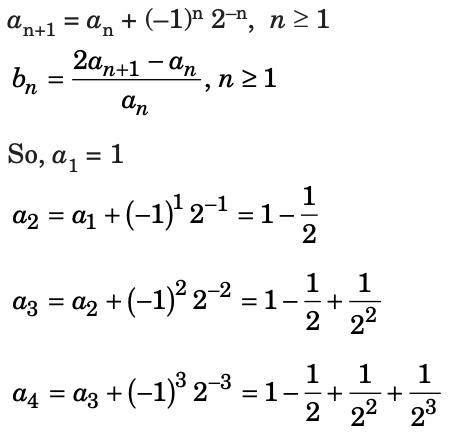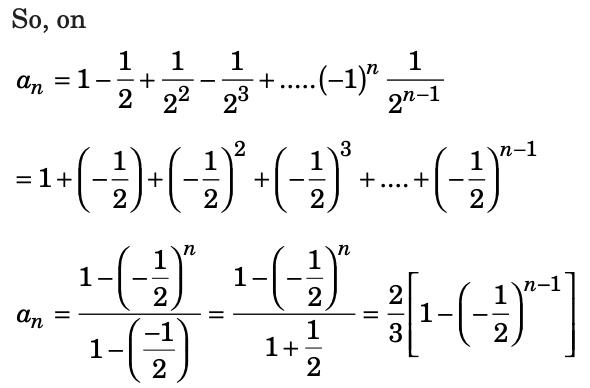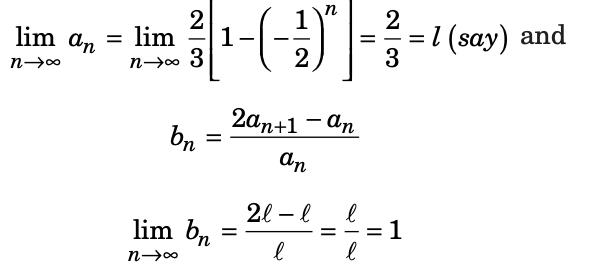Mathematics Exam > Mathematics Questions > Let {an} and {bn} be sequences of real number...
Start Learning for Free
Let {an} and {bn} be sequences of real numbers defined as a1 = 1 and for n ≥ 1, an+1 = an + (–1)n 2–n, bn =  . Then
. Then
- a){an} converges to zero and {bn} is Cauchy sequence
- b){an} converges to zero and {bn} is not a convergent sequence
- c){an} converges to a non-zero number and {bn} is a Cauchy sequence
- d){an} converges to a non-zero number and {bn} is not a convergent sequence
Correct answer is option 'C'. Can you explain this answer?
| FREE This question is part of | Download PDF Attempt this Test |
Verified Answer
Let {an} and {bn} be sequences of real numbers defined as a1 = 1 and f...
Let {an} & {bn} be sequences of real numbers defined as a1 = 1



⇒ {bn} converges to 1.
Hence {bn} will be a Cauchy sequence.
⇒ {bn} converges to 1.
Hence {bn} will be a Cauchy sequence.
Most Upvoted Answer
Let {an} and {bn} be sequences of real numbers defined as a1 = 1 and f...
Let {an} & {bn} be sequences of real numbers defined as a1 = 1



⇒ {bn} converges to 1.
Hence {bn} will be a Cauchy sequence.
⇒ {bn} converges to 1.
Hence {bn} will be a Cauchy sequence.
Free Test
FREE
| Start Free Test |
Community Answer
Let {an} and {bn} be sequences of real numbers defined as a1 = 1 and f...
Let {an} & {bn} be sequences of real numbers defined as a1 = 1



⇒ {bn} converges to 1.
Hence {bn} will be a Cauchy sequence.
⇒ {bn} converges to 1.
Hence {bn} will be a Cauchy sequence.

|
Explore Courses for Mathematics exam
|

|
Similar Mathematics Doubts
Let {an} and {bn} be sequences of real numbers defined as a1 = 1 and for n ≥ 1, an+1 = an + (–1)n 2–n, bn = . Thena){an} converges to zero and {bn} is Cauchy sequenceb){an} converges to zero and {bn} is not a convergent sequencec){an} converges to a non-zero number and {bn} is a Cauchy sequenced){an} converges to a non-zero number and {bn} is not a convergent sequenceCorrect answer is option 'C'. Can you explain this answer?
Question Description
Let {an} and {bn} be sequences of real numbers defined as a1 = 1 and for n ≥ 1, an+1 = an + (–1)n 2–n, bn = . Thena){an} converges to zero and {bn} is Cauchy sequenceb){an} converges to zero and {bn} is not a convergent sequencec){an} converges to a non-zero number and {bn} is a Cauchy sequenced){an} converges to a non-zero number and {bn} is not a convergent sequenceCorrect answer is option 'C'. Can you explain this answer? for Mathematics 2024 is part of Mathematics preparation. The Question and answers have been prepared according to the Mathematics exam syllabus. Information about Let {an} and {bn} be sequences of real numbers defined as a1 = 1 and for n ≥ 1, an+1 = an + (–1)n 2–n, bn = . Thena){an} converges to zero and {bn} is Cauchy sequenceb){an} converges to zero and {bn} is not a convergent sequencec){an} converges to a non-zero number and {bn} is a Cauchy sequenced){an} converges to a non-zero number and {bn} is not a convergent sequenceCorrect answer is option 'C'. Can you explain this answer? covers all topics & solutions for Mathematics 2024 Exam. Find important definitions, questions, meanings, examples, exercises and tests below for Let {an} and {bn} be sequences of real numbers defined as a1 = 1 and for n ≥ 1, an+1 = an + (–1)n 2–n, bn = . Thena){an} converges to zero and {bn} is Cauchy sequenceb){an} converges to zero and {bn} is not a convergent sequencec){an} converges to a non-zero number and {bn} is a Cauchy sequenced){an} converges to a non-zero number and {bn} is not a convergent sequenceCorrect answer is option 'C'. Can you explain this answer?.
Let {an} and {bn} be sequences of real numbers defined as a1 = 1 and for n ≥ 1, an+1 = an + (–1)n 2–n, bn = . Thena){an} converges to zero and {bn} is Cauchy sequenceb){an} converges to zero and {bn} is not a convergent sequencec){an} converges to a non-zero number and {bn} is a Cauchy sequenced){an} converges to a non-zero number and {bn} is not a convergent sequenceCorrect answer is option 'C'. Can you explain this answer? for Mathematics 2024 is part of Mathematics preparation. The Question and answers have been prepared according to the Mathematics exam syllabus. Information about Let {an} and {bn} be sequences of real numbers defined as a1 = 1 and for n ≥ 1, an+1 = an + (–1)n 2–n, bn = . Thena){an} converges to zero and {bn} is Cauchy sequenceb){an} converges to zero and {bn} is not a convergent sequencec){an} converges to a non-zero number and {bn} is a Cauchy sequenced){an} converges to a non-zero number and {bn} is not a convergent sequenceCorrect answer is option 'C'. Can you explain this answer? covers all topics & solutions for Mathematics 2024 Exam. Find important definitions, questions, meanings, examples, exercises and tests below for Let {an} and {bn} be sequences of real numbers defined as a1 = 1 and for n ≥ 1, an+1 = an + (–1)n 2–n, bn = . Thena){an} converges to zero and {bn} is Cauchy sequenceb){an} converges to zero and {bn} is not a convergent sequencec){an} converges to a non-zero number and {bn} is a Cauchy sequenced){an} converges to a non-zero number and {bn} is not a convergent sequenceCorrect answer is option 'C'. Can you explain this answer?.
Solutions for Let {an} and {bn} be sequences of real numbers defined as a1 = 1 and for n ≥ 1, an+1 = an + (–1)n 2–n, bn = . Thena){an} converges to zero and {bn} is Cauchy sequenceb){an} converges to zero and {bn} is not a convergent sequencec){an} converges to a non-zero number and {bn} is a Cauchy sequenced){an} converges to a non-zero number and {bn} is not a convergent sequenceCorrect answer is option 'C'. Can you explain this answer? in English & in Hindi are available as part of our courses for Mathematics.
Download more important topics, notes, lectures and mock test series for Mathematics Exam by signing up for free.
Here you can find the meaning of Let {an} and {bn} be sequences of real numbers defined as a1 = 1 and for n ≥ 1, an+1 = an + (–1)n 2–n, bn = . Thena){an} converges to zero and {bn} is Cauchy sequenceb){an} converges to zero and {bn} is not a convergent sequencec){an} converges to a non-zero number and {bn} is a Cauchy sequenced){an} converges to a non-zero number and {bn} is not a convergent sequenceCorrect answer is option 'C'. Can you explain this answer? defined & explained in the simplest way possible. Besides giving the explanation of
Let {an} and {bn} be sequences of real numbers defined as a1 = 1 and for n ≥ 1, an+1 = an + (–1)n 2–n, bn = . Thena){an} converges to zero and {bn} is Cauchy sequenceb){an} converges to zero and {bn} is not a convergent sequencec){an} converges to a non-zero number and {bn} is a Cauchy sequenced){an} converges to a non-zero number and {bn} is not a convergent sequenceCorrect answer is option 'C'. Can you explain this answer?, a detailed solution for Let {an} and {bn} be sequences of real numbers defined as a1 = 1 and for n ≥ 1, an+1 = an + (–1)n 2–n, bn = . Thena){an} converges to zero and {bn} is Cauchy sequenceb){an} converges to zero and {bn} is not a convergent sequencec){an} converges to a non-zero number and {bn} is a Cauchy sequenced){an} converges to a non-zero number and {bn} is not a convergent sequenceCorrect answer is option 'C'. Can you explain this answer? has been provided alongside types of Let {an} and {bn} be sequences of real numbers defined as a1 = 1 and for n ≥ 1, an+1 = an + (–1)n 2–n, bn = . Thena){an} converges to zero and {bn} is Cauchy sequenceb){an} converges to zero and {bn} is not a convergent sequencec){an} converges to a non-zero number and {bn} is a Cauchy sequenced){an} converges to a non-zero number and {bn} is not a convergent sequenceCorrect answer is option 'C'. Can you explain this answer? theory, EduRev gives you an
ample number of questions to practice Let {an} and {bn} be sequences of real numbers defined as a1 = 1 and for n ≥ 1, an+1 = an + (–1)n 2–n, bn = . Thena){an} converges to zero and {bn} is Cauchy sequenceb){an} converges to zero and {bn} is not a convergent sequencec){an} converges to a non-zero number and {bn} is a Cauchy sequenced){an} converges to a non-zero number and {bn} is not a convergent sequenceCorrect answer is option 'C'. Can you explain this answer? tests, examples and also practice Mathematics tests.

|
Explore Courses for Mathematics exam
|

|
Suggested Free Tests
Signup for Free!
Signup to see your scores go up within 7 days! Learn & Practice with 1000+ FREE Notes, Videos & Tests.


















